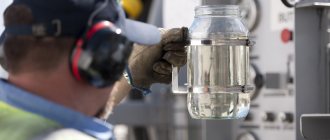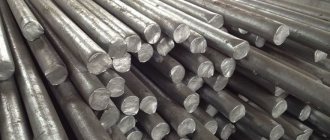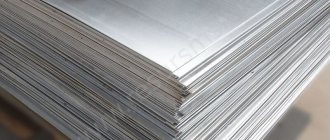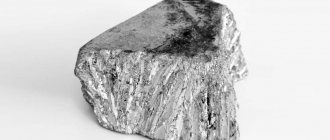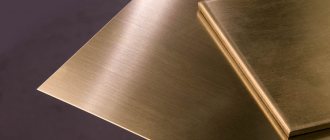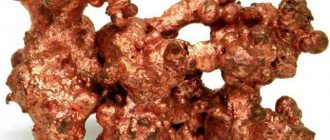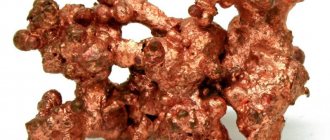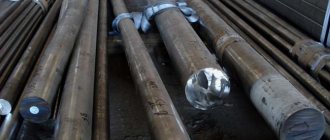Properties of zinc
Chemical properties of zinc
Zinc is an active metal. At room temperature it fades and becomes coated with a layer of zinc oxide.
- Reacts with many non-metals: phosphorus, sulfur, oxygen.
- When the temperature rises, it reacts with water and hydrogen sulfide, releasing hydrogen.
- When fused with alkalis, it forms zincates - salts of zinc acid.
- Reacts with sulfuric acid, forming various substances depending on the concentration of the acid.
- When heated strongly, it reacts with many gases: chlorine gas, fluorine, iodine.
- Does not react with nitrogen, carbon and hydrogen.
Physical properties of zinc
Zinc is a hard metal, but becomes ductile at 100–150 °C. At temperatures above 210 °C it may become deformed. The melting point is very low for metals. Despite this, zinc has good electrical conductivity.
- Density - 7.133 g/cm³.
- Thermal conductivity - 116 W/(m K).
- The melting point of zinc is 419.6 °C.
- Boiling point - 906.2 °C.
- The specific heat of evaporation is 114.8 kJ/mol.
- The specific heat of fusion is 7.28 kJ/mol.
- Specific magnetic susceptibility - 0.175·10-6.
- Tensile strength - 200–250 MN/m2.
The detailed chemical composition of various grades of zinc is shown in the table below.
| Brand designation | Zinc, no less | Impurity, no more | |||||||
| lead | cadmium | iron | copper | tin | arsenic | aluminum | Total | ||
| TsV00 | 99,997 | 0,00001 | 0,002 | 0,00001 | 0,00001 | 0,00001 | 0,0005 | 0,00001 | 0,003 |
| CV0 | 99,995 | 0,003 | 0,002 | 0,002 | 0,001 | 0,001 | 0,0005 | 0,005 | 0,005 |
| CV | 99,99 | 0,005* | 0,002 | 0,003 | 0,001 | 0,001 | 0,0005 | 0,005 | 0,01 |
| Ts0A | 99,98 | 0,01 | 0,003 | 0,003 | 0,001 | 0,001 | 0,0005 | 0,005 | 0,02 |
| Ts0 | 99,975 | 0,013 | 0,004 | 0,005 | 0,001 | 0,001 | 0,0005 | 0,005 | 0,025 |
| C 1 | 99,95 | 0,02 | 0,01 | 0,01 | 0,002 | 0,001 | 0,0005 | 0,005 | 0,05 |
| Ts2 | 98,7 | 1,0 | 0,2 | 0,05 | 0,005 | 0,002 | 0,01 | 0,010** | 1,3 |
| Ts3 | 97,5 | 2,0 | 0,2 | 0,1 | 0,05 | 0,005 | 0,01 | — | 2,5 |
| * In zinc used for the production of TsAM4-1o alloy, the mass fraction of lead should be no more than 0.004%. ** In zinc used for rolling, the mass fraction of aluminum should be no more than 0.005%. | |||||||||
The content of impurities in zinc depends on the production method and the quality of the raw materials.
In Russia, the main percentage of zinc is obtained by the hydrometallurgical method - the metal is reduced from salts in solutions. This method allows you to obtain the purest metal. But some zinc is processed at high temperatures. This method is called pyrometallurgical.
Lead is a special impurity in zinc, since most of it is deposited due to insoluble anodes contained in the metal. Cathode zinc, in addition to all these impurities, consists of chlorine and fluorine.
Galvanizing methods
Today, there are different technologies for applying zinc to the surface of products. It is necessary to consider each of them in detail.
Hot galvanizing method
The metal product is degreased, washed and etched in advance. Zinc is melted at a temperature of 450–480 °C. The part is lowered into the liquid metal. The operating principle of this method is based on the fact that iron and its alloys are well wetted. As a result, a coating of significant thickness from 40 to 450 microns is formed, due to which the product is reliably protected from corrosion. However, the hot method also has disadvantages. These include:
- uneven layer thickness;
- it is impossible to use the method for parts with precise tolerances, and in cases where the characteristics of the fastener change under the influence of high temperature.
There is also a possibility that after hot-dip galvanizing, the strength of the fastening will decrease, the so-called embrittlement. To avoid such a situation, the product must be thermally treated after applying zinc, but even this does not provide a complete guarantee. The method under consideration is not suitable for parts coated with paints or powder paints. The reason is the low adhesion between them and hot zinc.
Hot zinc surface treatment
Cold galvanizing method
This method has 2 more names: galvanic and electrolytic. In this case, the technology resembles the process of dyeing a product, but instead of paints, a special composition containing zinc is used. As a result, the part is coated with an anti-corrosion layer. Unlike the previous method, fasteners of any size and painted products can be cold galvanized. Using this method, increased chemical resistance is achieved. The weak points of the method include the small thickness of the layer - 5–35 microns, which leads to a decrease in anti-corrosion properties. The method under consideration, like the previous one, does not exclude the occurrence of embrittlement.
Thermal diffusion galvanizing method
The coating obtained using this method is a positive electrode, while the steel is negative. This is how electrochemical protection occurs. Thermal diffusion galvanizing can only be used for products whose materials are carbon steel, cast iron and low-impurity steel. The galvanizing process occurs as follows. The surface of the product is saturated with zinc, and the medium should be powder and the temperature should be 290–450 °C. The steel grade and product type affect the choice of temperature. In this way, you can achieve any thickness of the protective layer from 6 to 110 microns. With this method, a part is placed in a closed container and a special saturated mixture is added. Final treatment is required to ensure that white corrosion products do not form on the products when they come into contact with salt water and condensate.
The described technology is applicable to workpieces with threads and complex geometric shapes. As a result, a uniform layer is formed over the entire surface; zinc does not accumulate in recesses or joints. Thanks to this advantage, there is no need to remove the coating on the internal threaded part, as is necessary after hot-dip galvanizing. There is also no embrittlement, meaning this technology is suitable for high-strength fasteners. The level of anti-corrosion resistance is 1.5–2 times higher than with galvanic galvanizing, and 3–5 times higher than with the hot method. Also, this technology is characterized by high adhesion of the zinc layer to paints and high accuracy, so the scope of application also extends to structures with precise tolerances. The applied anti-corrosion layer is very wear-resistant and therefore suitable for parts that are frequently assembled and disassembled.
How do impurities change the properties of zinc
Manufacturers limit the content of cadmium, tin and lead in cast zinc alloys to suppress intergranular corrosion.
Tin is a harmful impurity. The metal does not dissolve and is released from the melt - it contributes to the fragility of zinc castings. Cadmium, on the contrary, dissolves in zinc and reduces its ductility when hot. Lead increases the solubility of the metal in an acidic environment.
Iron increases the hardness of zinc, but reduces its strength. At the same time, it complicates the process of filling molds during casting.
Copper increases the hardness of zinc, but reduces its ductility and resistance to corrosion. The copper content also interferes with the recrystallization of zinc.
The most harmful impurity is arsenic. Even with a small amount of it, the metal becomes brittle and less ductile.
To avoid edge cracking during hot rolling of zinc, the antimony content should not exceed 0.01%. When hot, it increases the hardness of zinc, depriving it of good ductility.
Metal oxidation reactions
Zinc oxidation occurs in air with the formation of an oxide film, which protects the surface from further destruction under the influence of reagents and prevents the displacement of hydrogen from water.
The oxidation state exhibited by a chemical element in compounds is +2.
- Zinc easily dissolves in dilute hydrochloric and sulfuric acids. As a result of the reaction, sulfuric acid is reduced to sulfur or hydrogen sulfide.
- As a result of the reaction of zinc with nitric acid, various acid reduction products are formed.
- When zinc reacts with a solution of potassium permanganate, the solution becomes discolored.
- The reaction of the metal with potassium vanadate is characterized by the reduction of vanadium with a sequential change in the color of the solution: yellow, blue, green, violet.
- Zinc metal dissolves in high concentration alkali solutions.
- Metal oxides can be obtained as a result of the thermal decomposition of carbonates and the synthesis of simple substances.
- Zinc salts are easily hydrolyzed. As a result of the reaction of zinc metal with a solution of metal chloride, hydrogen is released.
Zinc alloys
Zinc-based alloys with the addition of copper, magnesium and aluminum have a low melting point and have good fluidity. They are easy to process, weld and solder.
Brass
There are two-component and multi-component brasses.
Two-component brass is a zinc alloy with a high copper content. There is yellow brass with copper in the amount of 67%, golden copper or tombac - 75%, and green - 60%. Such alloys can be deformed at temperatures of 300 °C.
Multicomponent brasses, in addition to the 2 main metals, consist of other additives: nickel, iron, lead or manganese. Each of the elements affects the properties of the alloy.
TsAM
TsAM is a family of zinc alloys. They contain magnesium, aluminum and copper. Such zinc alloys are used in foundries. They contain aluminum in the amount of 4%.
The main area of application of TsAM alloys is zinc die casting. Alloys of this family have low melting points and good casting properties. Their high strength allows the production of durable and complex parts.
Virenium
The alloy consists of zinc (24.5%), copper (70%), nickel (5.5%).
Biological role
What is zinc from a medical and biological point of view? Does it matter for the life of organisms and how great is it? It turns out that zinc ions simply must be present in living beings. Otherwise, the deficit will lead to the following consequences:
- anemia;
- decreased insulin;
- allergies;
- weight loss and memory;
- fatigue;
- depression;
- blurred vision;
- irritability and others.
The main places of concentration of zinc ions in the human body are the pancreas, liver and muscles. It is also this metal that is part of most enzymes (for example, carbonic anhydrase). Therefore, most catalytic reactions occur with the participation of zinc.
What exactly do ions do?
- Participate in the synthesis of male hormones and seminal fluid.
- Promotes the absorption of vitamin E.
- Participate in the breakdown of alcohol molecules in the body.
- They are direct participants in the synthesis of many hormones (insulin, growth hormone, testosterone and others).
- Takes part in hematopoiesis and healing of damaged tissues.
- Regulates the secretion of the sebaceous glands, maintains normal hair and nail growth, and promotes regeneration processes in the skin.
- It has the ability to eliminate toxins from the body and strengthen the immune system.
- Affects the formation of taste sensations, as well as the sense of smell.
- Takes part in transcription processes, vitamin A metabolism, nucleic synthesis and decay.
- It is a participant in all stages of cell growth and development, and also accompanies the process of gene expression.
All this once again proves how important this metal is. Its role in biological systems was clarified only in the 20th century. Many troubles and illnesses in the past could have been avoided if people had known about treatment with zinc-based drugs.
How can you maintain the required amount of this element in the body? The answer is obvious. It is necessary to consume foods containing zinc. The list can be long, so we will indicate only those with the maximum number of the element in question:
- nuts and seeds;
- legumes;
- meat;
- seafood, especially oysters;
- cereals and bread;
- milk products;
- greens, vegetables and fruits.
Zinc production
Metal mining
Zinc as a native metal does not occur in nature. It is mined from polymetallic ores containing 1–4% metal in the form of sulfide, as well as copper, lead, gold, silver, bismuth and cadmium. The ores are enriched by selective flotation and zinc concentrates (50–60% Zn) are obtained.
Zinc concentrates are fired in furnaces. Zinc sulfide is converted to ZnO oxide. This releases sulfur dioxide SO2, which is used in the production of sulfuric acid.
Metal production
There are two ways to obtain pure zinc from ZnO oxide.
The most ancient method is distillation. The fired concentrated composition is subjected to heat treatment to give it granularity and gas permeability.
The concentrate is then reduced with coke or coal at a temperature of 1200–1300 °C. The process produces metal vapors, which are condensed and poured into molds. The liquid metal is separated from iron and lead at a temperature of 500 °C. This achieves zinc with a purity of 98.7%.
Sometimes complex and expensive processing of zinc by rectification is used - separation of mixtures due to the exchange of heat between steam and liquid. This cleaning allows you to obtain metal with a purity of 99.995% and remove cadmium.
The second method of producing zinc is electrolytic. The calcined concentrate is treated with sulfuric acid. The finished sulfate solution is cleaned of impurities, after which it is subjected to electrolysis in lead baths. Zinc deposits on aluminum cathodes. The resulting metal is removed from the baths and melted in induction furnaces. After this, electrolytic zinc with a purity of 99.95% is obtained.
Metal casting
Hot zinc is a liquid and flowing metal. Thanks to these properties, it is easily filled into molds.
Impurities affect the amount of surface tension of the zinc. The technological properties of the metal can be improved by adding small amounts of lithium, magnesium, tin, calcium, lead or bismuth.
The higher the overheating temperature of zinc, the better it fills molds. When casting metal into cast iron molds, its volume decreases by 1.6%. This makes it difficult to produce large and long zinc castings.
A Brief History of the Element's Discovery
People knew what zinc was even before our era. After all, it was then that they learned to use alloys containing this metal. The Egyptians used ores containing copper and zinc, smelted them and obtained a very strong, oxidation-resistant material. Household items and dishes made from this material were found.
The name zinc appears in the writings of the physician Paracelsus in the 16th century AD. During the same period, the Chinese began to actively use the metal, casting coins from it. Gradually, knowledge about this substance and its good technical properties is spreading to Europe. Then in Germany and England they also learned what zinc is and where it can be used.
Brass was one of the first and most famous alloys, used since ancient times in Cyprus and later in Germany and other countries.
The name comes from the Latin zincum, but the etymology is not entirely clear. There are several versions.
- From the German zinke, which translates as "edge".
- From the Latin zincum, meaning "white coating".
- Persian "cheng", that is, stone.
- Old German zinco, which translates as “plaque”, “eyesore”.
The element received its current name only at the beginning of the 20th century. The importance of zinc ions in the human body also became known only relatively recently (20th century). Before this, no ailments were associated with this element.
However, it is known that already in ancient times, many peoples used soups made from young lamb meat as a means of recovery from illness and for a speedy recovery. Today we can say that the effect was achieved due to zinc ions, which this dish contains quite a lot. It helped restore blood circulation, relieve fatigue and activated brain activity.
Applications of zinc
To protect metals from corrosion
Pure zinc is used to protect metals from corrosion. The base is covered with a thin film. This process is called metallization.
In the automotive industry
Zinc-based alloys are used to decorate car interiors and in the production of door handles, locks, mirrors and windshield wiper housings.
Zinc oxide is added to car tires, which improves the quality of the rubber.
In batteries, accumulators and other chemical power sources, zinc is used as a material for the negative electrode. In the production of electric vehicles, zinc-air batteries are used, which have a high specific energy intensity.
In the production of jewelry
Jewelers add zinc to gold-based alloys. As a result, they are easy to forge and become plastic - they firmly connect small parts of the product to each other.
The metal also brightens jewelry, which is why it is often used in white gold.
Galvanizing methods
Metallurgical plants are distinguished not only by their equipment, but also by the production methods used. It depends on the pricing policy, and location (natural resources used for the metallurgical industry). There are several galvanizing methods, which are discussed below.
Hot galvanizing method
This method involves dipping a metal part in a liquid solution. It happens like this:
- The part or product is degreased, cleaned, washed and dried.
- Next, the zinc is melted to a liquid state at temperatures up to 480 °C.
- The prepared product is lowered into the liquid solution. At the same time, it is well wetted in the solution and a coating up to 450 microns thick is formed. This is 100% protection against the effects of external factors on the product (moisture, direct sunlight, water with chemical impurities).
Hot galvanizing of metal structures
But this method has a number of disadvantages:
- The zinc film on the product results in an uneven layer.
- This method cannot be used for parts that meet exact standards according to GOST. Where every millimeter is considered a defect.
- After hot-dip galvanizing, not every part will remain strong and wear-resistant, since brittleness appears after passing through high temperatures.
This method is also not suitable for products coated with paints and varnishes.
Cold galvanizing
This method has 2 names: galvanic and electrolytic. The method of coating a product with corrosion protection is as follows:
- The metal part, the product is prepared (degreased, cleaned).
- After this, the “staining method” is carried out - a special composition is used, which has the main component - zinc.
- The part is coated with this composition by spraying.
Cold galvanizing
Thanks to this method, parts with precise tolerances and products coated with paints and varnishes are protected. Increases resistance to external factors leading to corrosion.
Disadvantages of this method: thin protective layer - up to 35 microns. This results in less protection and shorter protection periods.
Thermal diffusion method
This method makes a coating that is an electrode with positive polarity, while the metal of the product (steel) becomes negative polarity. An electrochemical protective layer appears.
The method is applicable only if the parts are made of carbon steel, cast iron, or steel with impurities. Zinc is used in the following ways:
- At temperatures from 290 °C to 450 °C in a powder medium, the surface of the part is saturated with Zn. Here, the marking of the steel, as well as the type of product, matter - the appropriate temperature is selected.
- The thickness of the protective layer reaches 110 microns.
- A product made of steel or cast iron is placed in a closed tank.
- A special mixture is added there.
- The last step is special treatment of the product to prevent the appearance of white efflorescence from salt water.
Thermal diffusion galvanizing
This method is mainly used when it is necessary to coat parts that have a complex shape: threads, small strokes. The formation of a uniform protective layer is important, since these parts undergo multiple exposures to external aggressive environments (constant moisture).
This method provides the highest percentage of product protection against corrosion.
Galvanized coating is wear-resistant and practically indelible, which is very important for parts that are rotated and disassembled from time to time
Examples of amphoteric hydroxides
The following hydroxides are amphoteric:
most d-element hydroxides:
chromium(III)hydroxideCr(OH)3{\displaystyle {\mathsf {Cr(OH)_{3}}}}, iron(III) oxide polyhydrate Fe(OH)3{\displaystyle {\mathsf {Fe(OH) )_{3}}}}, copper(II) hydroxide Cu(OH)2{\displaystyle {\mathsf {Cu(OH)_{2}}}}, zinc hydroxide Zn(OH)2{\displaystyle {\ mathsf {Zn(OH)_{2}}}}, cadmium hydroxide Cd(OH)2{\displaystyle {\mathsf {Cd(OH)_{2}}}},
and etc.;
series of p-element hydroxides:
aluminum hydroxide, Al(OH)3{\displaystyle {\mathsf {Al(OH)_{3}}}}, gallium hydroxide, Ga(OH)3{\displaystyle {\mathsf {Ga(OH)_{3} }}}, tin(II) oxide hydrate, Sn(OH)2{\displaystyle {\mathsf {Sn(OH)_{2}}}}, lead(II) hydroxide Pb(OH)2{\displaystyle {\ mathsf {Pb(OH)_{2}}}},
and etc.;
from hydroxides of s-elements:
beryllium hydroxide Be(OH)2{\displaystyle {\mathsf {Be(OH)_{2}}}};
Formally, water can be classified as amphoteric hydroxides.
Grounds. Amphoteric hydroxides
Bases, their classification, properties, preparation
| Bases are complex substances whose dissociation produces metal or ammonium ions and hydroxide ions OH-. NaOH <=> Na+ + OH- | Bases are substances that accept protons. NH3 + H+ = NH4+ |
1. Which of the following substances are bases: LiOH, CH3COOH, Fe(OH)2, CH3NH2, H2SO3, Mg(OH)2?
Classification of bases
| Signs of classification | Base groups | Examples |
| 1. Nature of substances | Inorganic | NaOH sodium hydroxide |
| Organic | CH3NH2 methylamine | |
| 2. Composition of substances (presence of oxygen) | Oxygen-free | NH3 -ammonia |
| Oxygen-containing | Cu(OH)2 - copper(II) hydroxide | |
| 3. Acidity of bases (based on the number of hydroxyl groups) | Mono-acid | KOH - potassium hydroxide |
| Diacid | Ca(OH)2 - calcium hydroxide | |
| 4. Degree of electrolytic dissociation | Weak | Fe(OH)2 - iron (II) hydroxide |
| Strong (alkalis) | NaOH sodium hydroxide | |
| 5. Solubility in water | Soluble (alkalis) | NaOH sodium hydroxide |
| Insoluble | Cu(OH)2 - copper(II) hydroxide | |
| 6. Volatility | Volatile | NH3 -ammonia |
| Non-volatile | Cu(OH)2 - copper(II) hydroxide | |
| 7. Heat resistance | Sustainable | KOH - potassium hydroxide |
| Unstable | Cu(OH)2 - copper(II) hydroxide |
2.
Characterize calcium hydroxide Ca(OH)2 according to all classification criteria.
RECEIVING
| Preparation of soluble bases (alkalis) | Preparation of insoluble bases |
| 1. Exchange reaction (if one of the products precipitates): Na2SO4 + Ba(OH)2 = BaSO4↓ + 2NaOH | Insoluble bases are obtained by an exchange reaction between a salt solution and an alkali solution: CuCl2 + 2NaOH = Cu(OH)2↓+ 2NaCl |
| 2. Soluble bases (alkalis) can be obtained by reacting an alkali and alkaline earth metal or their oxides with water: 2Na + 2H2O = 2NaOH + H2 CaO + H2O = Ca(OH)2 | |
| 3. Electrolysis of an aqueous solution of alkali metal chloride salts (chlorine is formed as a by-product): 2NaCl + 2H2O = 2NaOH + H2 + Cl2 (by electric current) |
3. Given substances: Fe(OH)2, Ca(OH)2, LiOH, Al(OH)3. Which substances are formed by the interaction of metals with water, and which by the action of an alkali on a salt solution?
Chemical properties of bases
1. Dissociation of bases with the formation of hydroxide ions OH-:
NaOH <=> Na+ + OH-LiOH <=> Li+ + OH-
2. Reaction with acids to form a salt (neutralization reaction):
Mg(OH)2 + 2HNO3 = Mg(NO3)2 + 2H2OMg(OH)2 + 2H+ = Mg2+ + 2H2O
3. Interaction of alkalis with acid oxides to form salt and water:
2NaOH + SiO2 = Na2SiO3 + H2O (when heated)Ca(OH)2 + CO2 = CaCO3↓ + H2O
4. The interaction of an alkali solution with solutions of various salts to form an insoluble base:
CuSO4 + 2NaOH = Cu(OH)2 ↓+ Na2SO4Cu2+ + 2OH- = Cu(OH)2 ↓
5. Decomposition of insoluble bases when heated to form metal oxide and water:
Cu(OH)2 = CuO + H2O (when heated)
6. Interaction of alkali solutions with some non-metals:
2NaOH + Cl2 = NaCl + NaClO + H2O (cold) 6NaOH + 3Cl2 = 5NaCl + NaClO3 + 3H2O (heated) 2NaOH + Si = Na2SiO3 + 2H2
- Interaction of alkali with some metals (forming amphoteric compounds).
??? 4. Given substances: CaO, SO2, Ba(OH)2, HClO4, KCl, CuCl2.
a) Which of the following substances react with sodium hydroxide?
b) Write equations for possible reactions.
c) Which of the following reactions is a neutralization reaction?
5. What substances decompose when heated: Fe(OH)2, NaOH, Al(OH)3, Fe(OH)3, Ba(OH)2? Write equations for possible reactions.
6. Three test tubes contain solutions of sodium chloride, hydrochloric acid, and sodium hydroxide. How can you recognize these solutions chemically?
7. What mass of alkali NaOH must be in solution to react with 16 g of copper (II) sulfate to obtain a precipitate of copper (II) hydroxide?
Amphoteric hydroxides
Amphoteric hydroxides are hydroxides that, upon dissociation, simultaneously form both H+ cations and OH- hydroxide ions. Amphoteric hydroxides correspond to amphoteric oxides. For example, Al(OH)3, Zn(OH)2, Cr(OH)3, Be(OH)2 and others.
1) Interaction of amphoteric hydroxides with acids:
Al(OH)3 + 3HCl = AlCl3 + 3H2O
Al(OH)3 + 3H+ = Al3+ + 3H2O
2) Interaction of amphoteric hydroxides with alkali:
Al(OH)3 + NaOH = Na[Al(OH)4] (sodium tetrahydroxoaluminate)Zn(OH)2 + 2NaOH = Na2[Zn(OH)4] (sodium tetrahydroxoaluminate)
3) They exhibit the properties of insoluble bases - they decompose when heated to form oxide and water:
2Al(OH)3 → Al2O3 + 3H2O
??? 8. a) Give examples of reactions that prove the properties of zinc hydroxide.
b) In which of the following reactions does zinc hydroxide manifest itself as an acid?
c) In which of the following reactions does zinc hydroxide manifest itself as a base?
d) Write the reaction equation for the production of zinc hydroxide.
Receipt
A common method for preparing amphoteric hydroxides is precipitation with dilute alkali from solutions of salts of the corresponding amphoteric element, for example:
ZnSO4 + 2NaOH ⟶ Zn(OH)2↓ + Na2SO4{\displaystyle {\mathsf {ZnSO_{4}\ +\ 2NaOH\ \longrightarrow \ Zn(OH)_{2}\downarrow \ +\ Na_{2}SO_{ 4}}}}
In excess of alkali, the hydroxide precipitate will begin to dissolve:
Zn(OH)2+2NaOH→Na2Zn(OH)4{\displaystyle {\mathsf {Zn(OH)_{2}+2NaOH\rightarrow Na_{2}}}}
In some cases, during precipitation, not a hydroxide is formed, but an oxide hydrate of the corresponding element (for example, hydrates of iron(III), chromium(III), tin(II), etc. oxides). The chemical properties of such hydrates are for the most part similar to those of the corresponding hydroxides.
Receipt
A common method for preparing amphoteric hydroxides is precipitation with dilute alkali from solutions of salts of the corresponding amphoteric element, for example:
ZnSO4 + 2NaOH ⟶ Zn(OH)2↓ + Na2SO4{\displaystyle {\mathsf {ZnSO_{4}\ +\ 2NaOH\ \longrightarrow \ Zn(OH)_{2}\downarrow \ +\ Na_{2}SO_{ 4}}}}
In excess of alkali, the hydroxide precipitate will begin to dissolve:
Zn(OH)2+2NaOH→Na2Zn(OH)4{\displaystyle {\mathsf {Zn(OH)_{2}+2NaOH\rightarrow Na_{2}}}}
In some cases, during precipitation, not a hydroxide is formed, but an oxide hydrate of the corresponding element (for example, hydrates of iron(III), chromium(III), tin(II), etc. oxides). The chemical properties of such hydrates are for the most part similar to those of the corresponding hydroxides.
Receipt
To obtain amphoteric metals, scientists use the same process used to isolate water-insoluble bases. Before carrying out work, it is necessary to obtain more information about the interaction of amphoteric compounds with alkalis, since metal will be released with the help of an alkaline solution.
Examples:
- To obtain zinc hydroxide, you need to mix a solution of zinc sulfate with sodium hydroxide.
- To obtain aluminum hydroxide, you need to mix a solution of aluminum sulfate with a solution of potassium hydroxide.
- To obtain trivalent hydroxides of chromium and aluminum, you need to mix a carbonate solution with a solution based on salts of these metals.
Aluminum hydroxide (Photo: Instagram / ostroukh_roman)
Examples of amphoteric hydroxides
The following hydroxides are amphoteric:
most d-element hydroxides:
chromium(III)hydroxideCr(OH)3{\displaystyle {\mathsf {Cr(OH)_{3}}}}, iron(III) oxide polyhydrate Fe(OH)3{\displaystyle {\mathsf {Fe(OH) )_{3}}}}, copper(II) hydroxide Cu(OH)2{\displaystyle {\mathsf {Cu(OH)_{2}}}}, zinc hydroxide Zn(OH)2{\displaystyle {\ mathsf {Zn(OH)_{2}}}}, cadmium hydroxide Cd(OH)2{\displaystyle {\mathsf {Cd(OH)_{2}}}},
and etc.;
series of p-element hydroxides:
aluminum hydroxide, Al(OH)3{\displaystyle {\mathsf {Al(OH)_{3}}}}, gallium hydroxide, Ga(OH)3{\displaystyle {\mathsf {Ga(OH)_{3} }}}, tin(II) oxide hydrate, Sn(OH)2{\displaystyle {\mathsf {Sn(OH)_{2}}}}, lead(II) hydroxide Pb(OH)2{\displaystyle {\ mathsf {Pb(OH)_{2}}}},
and etc.;
from hydroxides of s-elements:
beryllium hydroxide Be(OH)2{\displaystyle {\mathsf {Be(OH)_{2}}}};
Formally, water can be classified as amphoteric hydroxides.
Biocomplexes
Carbonic anhydrase: showing hydroxide group (red) attached to zinc (gray) Zinc fingers.
The zinc ion (green) is coordinated by two histidine residues and two cysteine residues. A very large number of metalloenzymes contain zinc (II). Also, many proteins contain zinc for structural reasons. The zinc ion is always four-coordinate with at least three ligands, which are amino acid side chains. In imidazole nitrogen, the histidine side chain is a common ligand. Below are typical examples of two types of zinc-protein complexes.
At the active resting site of carbonic anhydrase, the zinc ion is coordinated by three histidine residues. The fourth position is occupied by a water molecule, which, as in hydrolysis, is highly polarized (see above). When carbon dioxide enters the active site, a nucleophilic attack occurs on the oxygen atom, which carries a partial negative charge or a full negative charge if the water molecule is dissociated. Cooperation2 quickly converts to bicarbonate ion.[23]
[(-hys)3Zn (H2O)]2+ + CO2 → [(-hys)3Zn]2+ + HCO3− + H+
Some peptidases, such as glutamate carboxypeptidase II, are thought to act in a similar way: the zinc ion promotes the formation of a nucleophilic reagent.[23]
The zinc finger motif is a rigid substructure in a protein that facilitates the binding of the protein to another molecule, such as DNA.[24] In this case, all four coordination positions are occupied by histidine and cysteine residues. The tetrahedral geometry around the zinc ion constrains the α helix fragment and the antiparallel β sheet fragment into specific orientations relative to each other.
Magnesium ion, which has a higher concentration in biological fluids, cannot perform these functions because its complexes are much weaker than those of zinc.


